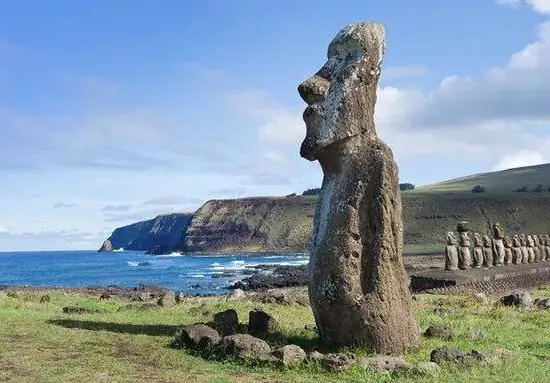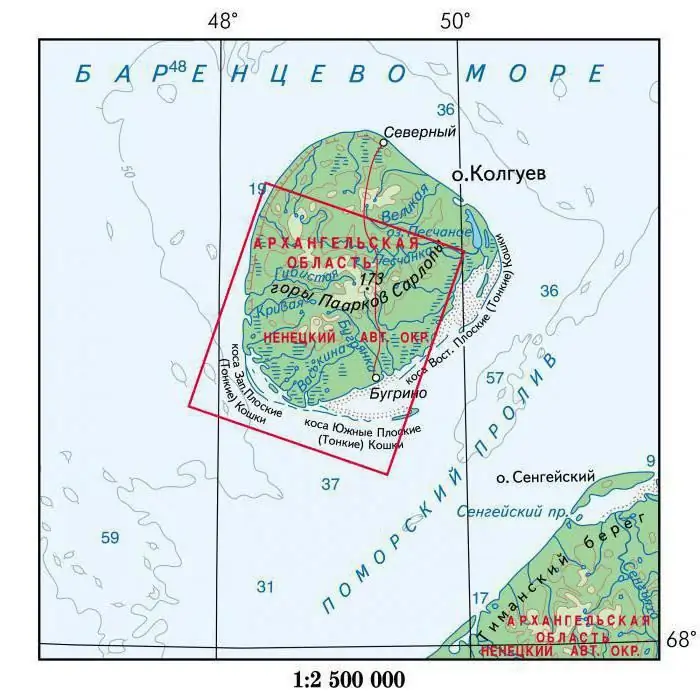- Author Harold Hamphrey [email protected].
- Public 2023-12-17 10:06.
- Last modified 2025-01-24 11:10.
The first settlers in this corner of the globe appeared in prehistoric times. The settlers, who came at that time from Siberia, began to develop these northern islands. Around 1250, a new wave of colonists came here, representing the Thule people (ancestors of the Eskimos). However, due to the severity of the climatic conditions of this area, the island eventually became depopulated around the middle of the 18th century.
To what part of the world does Ellesmere Island belong, and what does it represent? This and much more information is provided in the article.

Geographic location
Where is Ellesmere Island? It is the northernmost in Canada and belongs to the Kikiktani region.
This is the territory of Nunavut, which is the Canadian Arctic Archipelago, located east of Axel-Heiberg Island. Ellesmere is part of the Queen Elizabeth Islands. Its eastern part borders on Greenland. Repeatedly on the territory of Ellesmere Island found traces of animalsprehistoric times.
Characteristics of the island
Ellesmere has an area of 196,236 sq. km. It is the third largest island in Canada and the tenth largest in the world. Its highest point is Barbeau Peak (2616 meters) - the highest in the province of Nunavut. It should be noted that the northernmost point of Canada is Cape Columbia. Ellesmere Island coordinates: 80°10'00″ s. sh. 75°05'00″ W e.

The natural landscapes of a beautiful island in its own way are dominated by 3 details - completely bare rocks, snowfields and glaciers. Almost the entire coastline is represented by fjords that divide the island into several separate parts - lands that have the names of Ellesmere, Grant, Sverdrup and Grinnell. Approximately 1/3 of the island's surface is covered by glaciers.
In these places, the duration of the period of polar day and polar night is approximately 5 months.
Plant world
In places where Ellesmere Island is located, nature is represented by arctic tundra and deserts. Most of the island is part of the North American polar tundra ecological region (classified by the World Wildlife Fund).

Although the main territory of the island is freed from ice in summer, tree vegetation does not grow here, since such a period is not enough for this. Summers here are cool and short, and the ground thaws only a few centimeters deep. The vegetation here is mainlysmall foci - only in those places where there is protection from the wind. You can meet hollow-stem poppies and other types of herbaceous plants.
The largest green oasis is the area near Lake Hazen, on the banks of which sedge, creeping willow, ericaceous shrubs and saxifrage bloom in summer.
Animal world
In comparison with the flora, the fauna of Ellesmere Island (Canada) is more diverse. There are polar hares, musk bulls, non-migrating south Piri caribou deer (smaller and lighter in color than the mainland) and other animals.

Like other Canadian Arctic islands, Ellesmere is home to the Melville island wolf, a subspecies of the common wolf. It differs in smaller sizes and light gray or white fur.
Nest on the island in the summer and several varieties of birds. This is a snowy owl, polar tern, and from settled ones - tundra partridge and snow bunting.
Due to the harsh climate and the scarcity of vegetation cover, the issue of survival for animals living in these places is very acute. In 1988, to preserve this fragile nature, part of the island, which includes Lake Hazen, was declared a national park.

Brief historical information
As noted above, the first inhabitants of Ellesmere Island appeared a long time ago (in prehistoric times). However, it is believed that it was discovered by the English navigator William Buffin in 1616. Himthe first description of the island was made. And the name was given to him in 1852 in honor of the famous English statesman, traveler and writer Francis Egerton (life period - 1800-1857) (Earl of Ellesmere).
Off the coast of Ellesmere, on the small island of Pym, in 1883-1884. members of the Arctic American expedition of Adolf Greely spent the winter.
One curious fact should be noted here. In August 2005, a huge block of ice separated from the Ailes Ice Shelf, located near Ellesmere, as a result of a cleavage, which collapsed into the waters of the Arctic Ocean. After this incident, the ice shelf almost ceased to exist.

Climatic conditions
The climate of Ellesmere Island is polar arctic. Winters are very cold here, the air temperature can reach up to -50 °C. The temperature of the summer months rarely exceeds +7 °С, but on some days it can reach +21 °С.
Total annual precipitation is approximately 60mm of rain, snow and condensation. The snow cover is very thin.
Due to constant frost, the process of evaporation of moisture is difficult, so the island has very little rainfall and low humidity.
Population
In 2006, despite the large area of the island, only 146 local residents lived here.
There are 3 settlements on it - Gris-fjord, Eureka and the northernmost settlement on the planet with permanent residents - Alert.

Paleontology
Ellesmere Island is also interesting in terms of paleontology, where paleontological remains were found in its western territories. They are fossils of organisms, whose age is approximately 3.7 million years. This is a combination (biocenosis) of the boreal forest (taiga) of the Pliocene era with mammals (hare, bear, beaver, camels, dogs). At the time of that era, the average annual temperatures in the North American Arctic were much higher than now.
Greenland larch was the dominant tree species in the Pliocene taiga. Other tree species are birch, alder, spruce, thuja and pine.
And the amount of precipitation during that period was much more significant and amounted to about 550 mm per year. The fauna of those times was very similar to the fauna of East Asia of the same era. Fossils of other animals have been found here, including the big wolverine, shrew, marten, weasel, ancient horse (plesiohipparion), badger, deer-like, etc.

In conclusion, some interesting facts
Paleontologists (scientists from the University of Colorado and the Academy of Sciences in Beijing) have confirmed that the non-flying bird Gastornis lived on Canada's Ellesmere Island 50 million years ago (Cenozoic era). This is a fairly large individual that lived in the late Paleocene and Eocene. It reached a height of about two meters, and its weight was about 100 kg. Her remains were found by scientists in the 70s of the last century, but they were studied in detail only recently.
The only evidence that the bird livedon a Canadian island, a single bone found (a phalanx of a toe) serves. It is practically a copy of the gastornis remains found in Wyoming. The latter date from the same time.
According to scientists, the conditions of the nature of Ellesmere Island of those times resembled the current cypress swamps located in the south of the United States. Fossils have also been preserved on the island, indicating that alligators with turtles, primates with tapirs, as well as large rhinoceros and hippo-like mammals lived on it.
Earlier, in the same area, researchers discovered the remains of another anseriform bird, the presbyornis, which, unlike gastornis, could fly.






